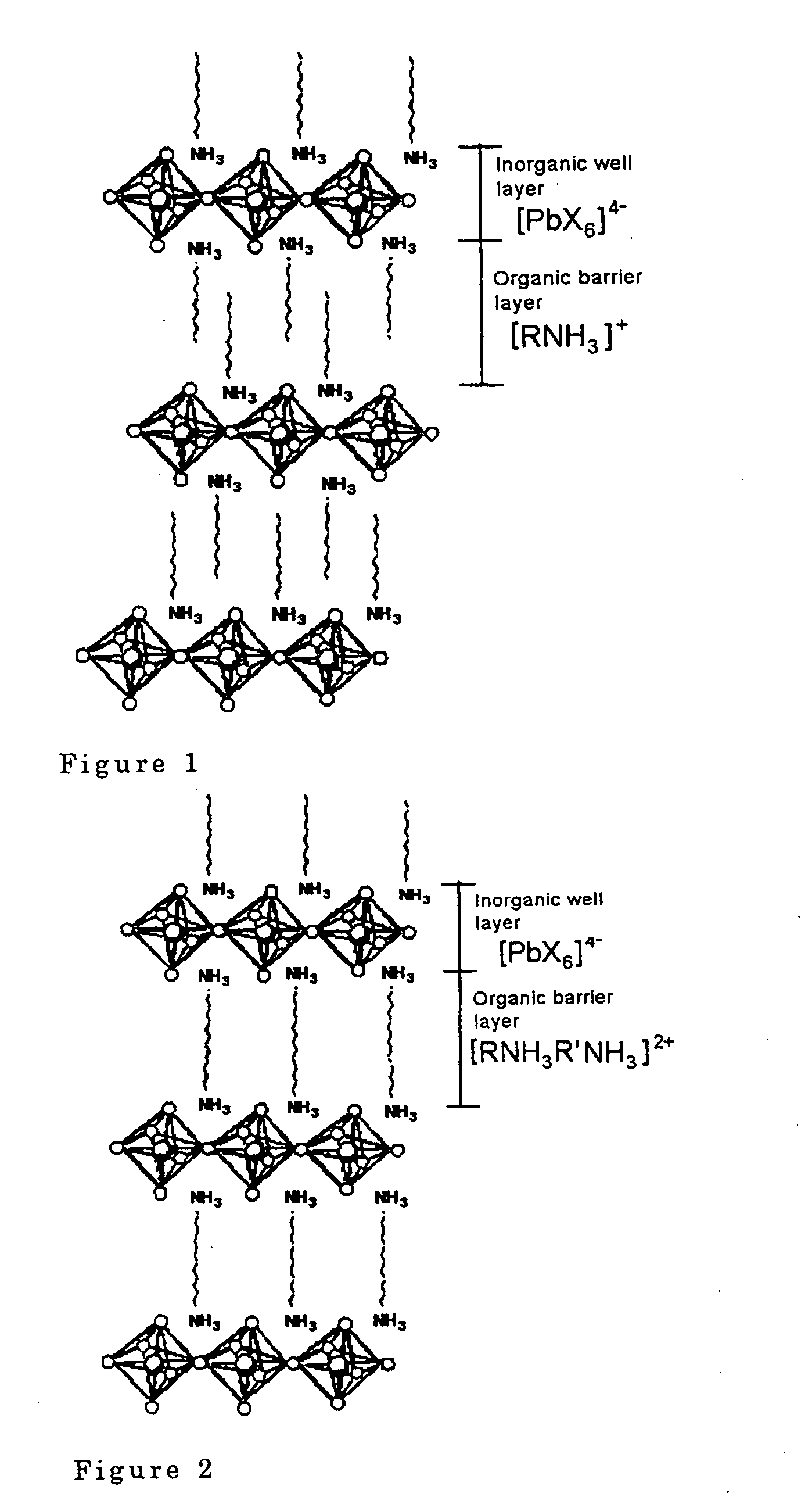Radiation detection
a technology of radiation detection and scintillator material, applied in the field of radiation detection, can solve the problems of low fluorescence efficiency, small photoemission amount, and inability to meet all these conditions at the same tim
- Summary
- Abstract
- Description
- Claims
- Application Information
AI Technical Summary
Benefits of technology
Problems solved by technology
Method used
Image
Examples
example 1
[0040] A laminar perovskite compound (C.sub.6H.sub.13NH.sub.3).sub.2PbI.su-b.4 was synthesized by reacting lead iodide PbI.sub.2 as a halogenated metal and C.sub.6H.sub.13NH.sub.3I as an organic amine halogenated hydroacid salt in a molar ratio of 1:2 in N,N'-dimethylformamide (reaction temperature: room temperature (20 degree C.), reaction time: 1 hour or more).
[0041] 1 g of this laminar perovskite compound was dissolved in 3 ml of acetone, and spin-coated on a silicon (Si) substrate of 2 cm angle using a Shimadzu Laboratories P / N 202-32016 (rotation speed: 5000 rpm, time: 30 seconds or more) to manufacture a scintillator (thickness of laminar perovskite compound 0.1 .mu.m). Here, a silicon substrate was used to avoid photoemission from the substrate.
[0042] FIG. 3 shows the radiation detection device used in this example. This device comprises a stainless steel cylinder of diameter approximately 50 cm, and comprises a window through which the radiation enters, a light receiving por...
example 2
[0047] The absorbed radiation amount was varied from 4.2.times.10.sup.6 Gy-1.5.times.10.sup.7Gy, and the relation between the absorbed radiation amount of the laminar perovskite compound and radiation intensity of the exciton photoemission (exciton photoemission amount) was investigated as in the case of Example 1. FIG. 5 shows the relation between the radiation intensity of the exciton photoemission and the absorbed radiation amount of (C.sub.6H.sub.13NH.sub.3)PbI.sub.4. This radiation intensity was computed from the peak (524.+-.0.5 nm) of the exciton photoemission shown in FIG. 4.
[0048] From FIG. 5, it is seen that this exciton photoemission amount decreases gradually as the absorbed radiation amount increases. Therefore, the radiation amount can be directly calculated from the photoemission amount. In other words, the radiation detection device of this invention can measure the radiation amount. Further, the fact that the exciton photoemission amount has this constant functional...
example 3
[0049] The scintillator manufactured in Example 1 was excited using a pulse electron beam of pulse width 1 picosecond accelerated to 30 MeV by a linear accelerator (LINAC) in a vacuum (approximately 10.sup.-6 Torr), and the time shift of the integrated intensity of the excited photoemission was measured. The photoreceptor was a streak camera (Yokohama Photonics Corporation, FESCA-200) having a time resolution of 260 femtoseconds. FIG. 6 shows the results. From analyzing this graph, the time constant of the decay of this photoemission was approximately 45 picoseconds.
PUM
| Property | Measurement | Unit |
|---|---|---|
| thickness | aaaaa | aaaaa |
| diameter | aaaaa | aaaaa |
| wavelength | aaaaa | aaaaa |
Abstract
Description
Claims
Application Information
 Login to View More
Login to View More - R&D
- Intellectual Property
- Life Sciences
- Materials
- Tech Scout
- Unparalleled Data Quality
- Higher Quality Content
- 60% Fewer Hallucinations
Browse by: Latest US Patents, China's latest patents, Technical Efficacy Thesaurus, Application Domain, Technology Topic, Popular Technical Reports.
© 2025 PatSnap. All rights reserved.Legal|Privacy policy|Modern Slavery Act Transparency Statement|Sitemap|About US| Contact US: help@patsnap.com



